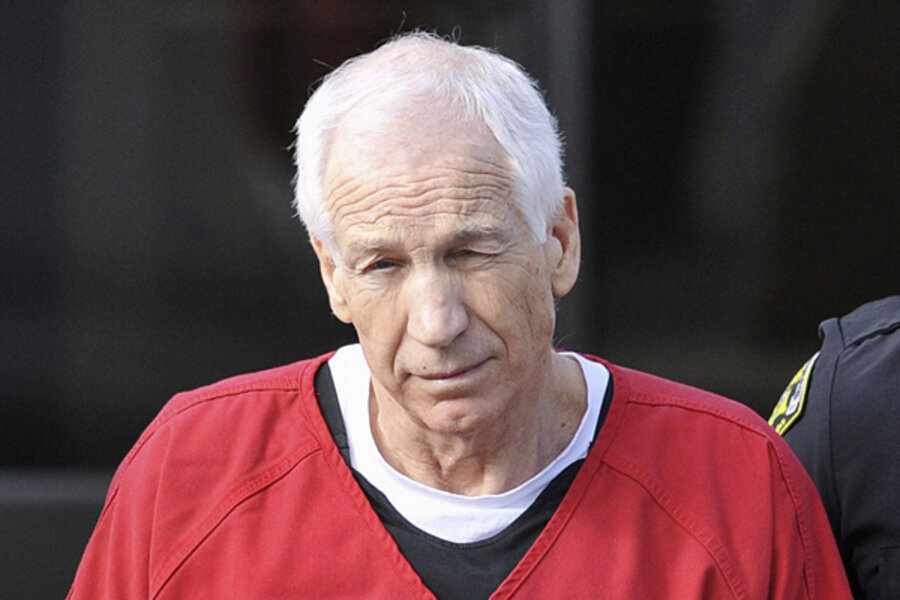Penn State to pay nearly $60 million to 26 Sandusky victims
Loading...
| Harrisburg, Pa.
Penn State said Monday it is paying $59.7 million to 26 young men over claims of child sexual abuse at the hands of former assistant football coach Jerry Sandusky.
The school said 23 deals are fully signed and three are agreements in principle, but it did not disclose the names of the recipients. The school faces six other claims, and the university says it believes some of those do not have merit while others may produce settlements.
University president Rodney Erickson issued a statement calling the announcement a step forward for victims and the school.
"We cannot undo what has been done, but we can and must do everything possible to learn from this and ensure it never happens again at Penn State," said Erickson, who announced the day Sandusky was convicted in June 2012 that Penn State was determined to compensate his victims.
The settlements have been unfolding since mid-August, when attorneys for the accusers began to disclose them. Penn State has not been confirming them, waiting instead to announce deals at once.
Harrisburg lawyer Ben Andreozzi, who helped negotiate several of the settlements, said his clients were satisfied.
"They felt that the university treated them fairly with the economic and noneconomic terms of the settlement," said Andreozzi, who also represents some others who have come forward recently. Those new claims have not been presented to the university, he said.
One client represented by St. Paul, Minn., attorney Jeff Anderson signed off on an agreement in the past week and the other is basically done, he said. Anderson counts his two clients as among the three that have been classified as agreements in principle, which Penn State said means final documentation is expected to be completed in the next few weeks.
Anderson said his clients were focused on Penn State's changes to prevent future abuse.
"I have to applaud them, because they said 'not until we're satisfied that no one else will get hurt,'" Anderson said. "The settlement of their cases in no way heals, in no way lessens the wound that remains open and the scars that are deep."
Penn State has spent more than $50 million on other costs related to the Sandusky scandal, including lawyers' fees, public relations expenses, and adoption of new policies and procedures related to children and sexual abuse complaints.
It said Monday that liability insurance is expected to cover the payments and legal defense, and expenses not covered should be paid from interest paid on loans by Penn State to its self-supporting units.
Clifford Rieders, a Williamsport attorney who negotiated one of the settlements, said the average payout matched other cases involving child abuse in educational or religious settings.
Rieders said the cases raised the specter of embarrassing revelations if they went to trial, and a university would have to consider the effect on the victims, its overall reputation, its ability to pay and its wider objectives.
"There are many considerations whenever you resolve a high-profile case involving serious misconduct, and I'm sure all of those and more came into play here," Rieders said.
Sandusky, 69, has been pursuing appeals while he serves a 30- to 60-year state prison sentence on 45 criminal counts.
He was convicted of abusing 10 boys, some of them at Penn State facilities. Eight young men testified against him, describing a range of abuse when they were boys.
The 32 claimants involved in negotiations with Penn State include most of the victims from the criminal trial and some who say they were abused by Sandusky many years ago. Negotiations were conducted in secret, so the full range of the allegations hasn't been disclosed publicly.
Sandusky did not testify at his trial but has long asserted his innocence. He has acknowledged he showered with boys but insisted he never molested them.
The abuse scandal rocked Penn State, bringing down football coach Joe Paterno and leading college sports' governing body, the NCAA, to levy unprecedented sanctions against the university's football program.
Three former Penn State administrators await trial in Harrisburg on charges they engaged in a criminal cover-up of the Sandusky scandal. Former president Graham Spanier, retired vice president Gary Schultz and retired athletic director Tim Curley deny the allegations, and a trial date has not been scheduled.







